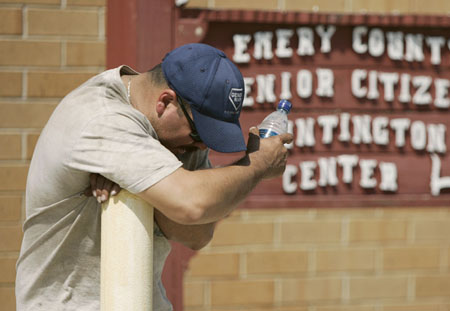6 trapped in Utah coal mine cave-in
(AP)Updated: 2007-08-07 09:26
HUNTINGTON, Utah -- Hundreds of rescuers broke through walls of rock Monday in a desperate race to reach six coal miners trapped 1,500 feet below ground by a cave-in so powerful authorities initially thought it was an earthquake.
Miners starting an evening shift joined the rescue effort.
"We're going to get them," said Robert E. Murray, chairman of Murray Energy Corp. of Cleveland, a part owner of the Crandall Canyon mine. "There is nothing on my mind right now except getting those miners out."
The mining crew was believed to be about four miles from the mine entrance. Rescuers were working to free the men by drilling into the mine vertically from the mountaintop and horizontally from the side, Murray said.
If they are able to open an old mine shaft, he added, rescuers believe they can get within 100 feet of where the men are trapped.
"The idea is to get a hole into where they are," Murray said. "They could be in a chamber 1,000 feet long or they could be dead. We just don't know right now."
Doug Johnson, director of corporate services at an affiliated company, UtahAmerican Energy, said rescuers had made "decent progress," but they were not much closer to the men.
Federal mine-safety inspectors, who have issued more than 300 citations against the mine since January 2004, were also on hand to help oversee the search.
Murray said no expense would be spared to save the men. The company had enlisted the help of 200 employees and four rescue crews, and brought in all available equipment from around the state.
The mine is built into a mountain in the rugged Manti-La Sal National Forest, 140 miles south of Salt Lake City, in a sparsely populated area.
 |
A coal miner from the collapsed
Genwal mine who wished not to be identified stands outside a senior center
in Huntington, Utah, August 6, 2007. [Reuters] |
University of Utah seismograph stations recorded seismic waves of 3.9 magnitude early Monday in the area of the mine, causing speculation that a minor earthquake had caused the cave-in. Scientists later realized the collapse at the mine had caused the disturbance.
"There is no evidence that the earthquake triggered the mine collapse," said Walter Arabasz, director of the seismography stations.
Murray disputed those findings, saying the epicenter was a mile from the trapped miners.
"The whole problem has been caused by an earthquake," Murray angrily insisted.
Since the mid-1990s, at least a half-dozen other mine collapses have caused similar seismic waves, including a 1995 cave-in in southwestern Wyoming that caused readings as high as a magnitude 5.4.
Murray believed the miners have plenty of air because oxygen naturally leaks into the mine. The mine also is stocked with drinking water.
"I'm so hopeful for those guys. They should have lots of oxygen to breathe," said Mary Ann Wright, associate director for mining in the Utah Division of Oil, Gas and Mining.
"From not having heard that there's any type of fire, that's always good news. If they're trapped in a cavern area, there should be oxygen to breathe," Wright said.
Government mine inspectors have issued 325 citations against the mine since January 2004, according to a quick analysis of federal Mine Safety and Health Administration online records. Of those, 116 were what the government considered "significant and substantial," meaning they are likely to cause injury.
The 325 safety violations is not unusual, said J. Davitt McAteer, former head of the MHSA and now vice president of Wheeling Jesuit University in West Virginia.
"It's not perfect but it's certainly not bad," McAteer said. "It would be in the medium range."
In 2007, inspectors have issued 32 citations against the mine, 14 of them considered significant.
Last month, inspectors cited the mine for violating a rule requiring that at least two separate passageways be designated for escape in an emergency.
It was the third time in less than two years that the mine had been cited for the same problem, according to MSHA records. In 2005, MSHA ordered the mine owners to pay $963 for not having escapeways and the 2006 fine for the same problem was just $60.
Overall, the federal government has ordered the mine owner to pay nearly $152,000 in penalties for its 325 violations with many citations having no fines calculated yet. Since January, the mine owner has paid $130,678 in fines, according to MSHA records.
Asked about safety, Murray told reporters: "I believe we run a very safe coal mine. We've had an excellent record."
Gov. Jon Huntsman broke away from a wildfire forum in Boise, Idaho, to return to Utah.
"We're going to expend every resource we have and make every effort to make sure lives are put first and foremost," he said as he departed Boise.
The head of MSHA, Richard Stickler, said he would be at the site Tuesday.
Utah ranked 12th in coal production in 2006. It had 13 underground coal mines in 2005, the most recent statistics available, according to the Utah Geological Survey.
Emery County, the state's No. 2 coal-producer, also was the site of a fire
that killed 27 people in the Wilburg mine in December 1984.
|
|
|
||
|
||
|
|
